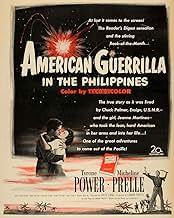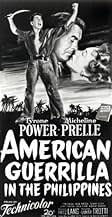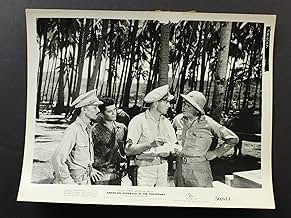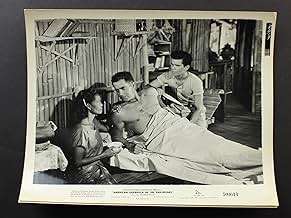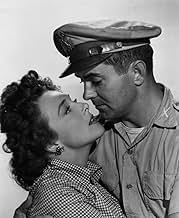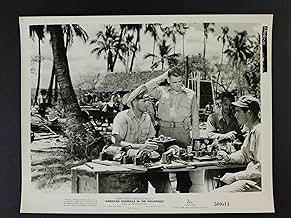IMDb RATING
5.9/10
1.4K
YOUR RATING
American soldiers stranded in the Philippines after the Japanese invasion form guerrilla bands to fight back.American soldiers stranded in the Philippines after the Japanese invasion form guerrilla bands to fight back.American soldiers stranded in the Philippines after the Japanese invasion form guerrilla bands to fight back.
Micheline Presle
- Jeanne Martinez
- (as Micheline Prelle)
Robert Patten
- Lovejoy
- (as Bob Patten)
Miguel Anzures
- Native Traitor
- (uncredited)
Sabu Camacho
- Bo
- (uncredited)
Erlinda Cortes
- Partisan
- (uncredited)
Cris de Vera
- Japanese Officer
- (uncredited)
Rosa Del Rosario
- Partisan
- (uncredited)
Maria del Val
- Señora Martinez - the Aunt
- (uncredited)
Vic Diaz
- Japanese General
- (uncredited)
Arling Gonzales
- Radio Operator
- (uncredited)
Fred Gonzales
- Radio Operator
- (uncredited)
Eddie Infante
- Col. Dimalanta
- (uncredited)
- Director
- Writers
- All cast & crew
- Production, box office & more at IMDbPro
Featured reviews
Had BACK TO BATAAN and BACK TO BATAAN not been made, then I assume that American GUERILLA IN THE PHILIPPINES would probably be a better remembered film. That's because it's an excellent movie in just about every way, but the earlier John Wayne and Robert Taylor films about the Philippines during WWII were very outstanding films and tend to overshadow this Tyrone Power flick.
While the plot is not identical to these other two films, there are many similarities. All three document the heroic efforts of the Philippino partisans as well as that of Americans stuck in this land during the war. About the only noticeable difference was that the Power film was in color and I really think for this subject matter, black and white actually worked better--looking more like what you'd expect a WWII film to look like. Plus, the other two films are just a little more exciting and involving--but this isn't to say this Power film is bad--it just isn't quite as involving.
Still, among the many, many WWII films, this one is a bit better than average and well worth a peek. And, yes, I also noticed the line that said a Navy Ensign is equivalent to an Army Major! I'm surprised that Power, with his WWII experience, would have said such a stupid line. An ensign is most closely equivalent to an Army Lieutennant--a much lower rank.
While the plot is not identical to these other two films, there are many similarities. All three document the heroic efforts of the Philippino partisans as well as that of Americans stuck in this land during the war. About the only noticeable difference was that the Power film was in color and I really think for this subject matter, black and white actually worked better--looking more like what you'd expect a WWII film to look like. Plus, the other two films are just a little more exciting and involving--but this isn't to say this Power film is bad--it just isn't quite as involving.
Still, among the many, many WWII films, this one is a bit better than average and well worth a peek. And, yes, I also noticed the line that said a Navy Ensign is equivalent to an Army Major! I'm surprised that Power, with his WWII experience, would have said such a stupid line. An ensign is most closely equivalent to an Army Lieutennant--a much lower rank.
This movie had a rush release just weeks before American soldiers get serious in Korea. A very good feel from this war drama about American fighters stranded in the Philippine Islands waiting for Gen. Douglas MacArthur's return. Guerrilla warfare helps sustain against the invading Japanese in 1942. Some very nice scenery and interesting war action. Top direction from Fritz Lang and potent acting from Tyrone Power and Tom Ewell.
Not one to see a lot of war films, I have to say I enjoyed "American Guerilla in the Philippines," starring Tyrone Power and directed by Fritz Lang. Power plays a real-life navy man, Chuck Parsons, who helped organize guerrilla forces in the Philippines after MacArthur promised to return. There are some exciting and tense scenes, and also, the film is a tribute to the courage of the Filipinos. There are obvious non-actors in small roles, which is a little distracting, but I suppose this was done for the sake of realism. Power is rugged and handsome as Parsons, and Tom Ewell gives an excellent performance as a wisecracking soldier. Micheline Presle is the de rigeur love interest - it's Tyrone Power who's starring, after all, and their love scenes are great, as are their scenes where she subtly fights her attraction to him. Of course, I'd have caved right in.
Power did not get to meet the real Chuck Parsons until a few months after filming, when Parsons appeared, unannounced, in Power's dressing room when the actor was performing "Mr. Roberts" in London. One must assume Parsons was pleased to have been portrayed by a matinée idol.
Fritz Lang did a wonderful job of directing, but of course, this film is a far cry from Metropolis. It was a hard shoot for Power, as his wife, Linda Christian, miscarried while visiting him on location.
Despite other reviews on this page, Amrican Guerrilla is very watchable. You have to take it for what it is - propaganda to get the U.S. ready for the Korean war.
Power did not get to meet the real Chuck Parsons until a few months after filming, when Parsons appeared, unannounced, in Power's dressing room when the actor was performing "Mr. Roberts" in London. One must assume Parsons was pleased to have been portrayed by a matinée idol.
Fritz Lang did a wonderful job of directing, but of course, this film is a far cry from Metropolis. It was a hard shoot for Power, as his wife, Linda Christian, miscarried while visiting him on location.
Despite other reviews on this page, Amrican Guerrilla is very watchable. You have to take it for what it is - propaganda to get the U.S. ready for the Korean war.
This is a seldom referenced and very overlooked old movie, but Fritz Lang still shows what an amazing filmmaker he is here. The script is good (not great) but the direction and some surprisingly good acting turn this one into a real winner. Definitely worth watching.
There were hundreds of these cheap-ish World War Two quickies in the decade following the close of the conflict itself. They differed little from those produced during the war, still being in a kind of adulatory propagandistic mode, except that they were a little more vague usually having no direct message. What's more, as more time went by the seemed to get further and further from the realities of the conflict.
An American Guerrilla in the Philippines sees Tyrone Power, swashbuckling idol of the pre-war years, as an officer battling Japs in the Philippine jungle. Power has matured as an actor since his pictures a decade earlier, appearing tougher and less boyish, although he has also become less interesting in the process. His performance is steady and natural, but he is unable to make anything of what is admittedly a rather bland character on paper anyway. His buddy Tom Ewell is an unusual addition to the cast. He was in later years a very fine comedy actor, but it's hard to tell if he's appearing here as comic relief or not. In some moments, such as his burbling in the water trying to stay afloat, seem as if he is trying to play them for laughs, inappropriately if so, and certainly not at all funny. The rest of the cast is simply plain bad or plain boring.
Director Fritz Lang is normally someone who can give a nice baroque touch to even the most American of film formats, while still remain true to genre and tone. He seems uncertain however quite what to do with this one. He gives many shots in the jungle an abstract feel, with no familiar points of reference, giving them a threateningly wild look. Often his camera takes a spectator's position, peeping out through foliage. It's hard to tell what purpose this serves, as it distances us from the events on screen. Incidentally, Lang was a very good director of crowds and action, as evidenced in his big-budget silent pictures. There are some very powerful moments, with characters moving straight towards us down the middle of the shot and memorably stylised movements. However for a director who is normally so good at imbuing his work with a dark and nightmarish feel, An American Guerrilla in the Philippines has none of the bleak terror of, say, Operation Burma, a picture which really worked because it made us the audience feel lost within the jungle ourselves.
And ultimately An American Guerrilla in the Philippines is too light, and too sparing on any true sense of tragedy. It's lack of a real feeling of danger gives it many dull stretches, and its lack of realism does a disservice to those involved in the conflict. All of which is rather odd because the picture is also far from being a comedy. The only thing which saves it and makes it watchable is Fritz Lang's strong, vibrant imagery, such as dozens of hats waving in the air or a soldier's dying scream just inches from the lens. Having said that, there are far better Fritz Lang pictures to see these brilliant touches in.
An American Guerrilla in the Philippines sees Tyrone Power, swashbuckling idol of the pre-war years, as an officer battling Japs in the Philippine jungle. Power has matured as an actor since his pictures a decade earlier, appearing tougher and less boyish, although he has also become less interesting in the process. His performance is steady and natural, but he is unable to make anything of what is admittedly a rather bland character on paper anyway. His buddy Tom Ewell is an unusual addition to the cast. He was in later years a very fine comedy actor, but it's hard to tell if he's appearing here as comic relief or not. In some moments, such as his burbling in the water trying to stay afloat, seem as if he is trying to play them for laughs, inappropriately if so, and certainly not at all funny. The rest of the cast is simply plain bad or plain boring.
Director Fritz Lang is normally someone who can give a nice baroque touch to even the most American of film formats, while still remain true to genre and tone. He seems uncertain however quite what to do with this one. He gives many shots in the jungle an abstract feel, with no familiar points of reference, giving them a threateningly wild look. Often his camera takes a spectator's position, peeping out through foliage. It's hard to tell what purpose this serves, as it distances us from the events on screen. Incidentally, Lang was a very good director of crowds and action, as evidenced in his big-budget silent pictures. There are some very powerful moments, with characters moving straight towards us down the middle of the shot and memorably stylised movements. However for a director who is normally so good at imbuing his work with a dark and nightmarish feel, An American Guerrilla in the Philippines has none of the bleak terror of, say, Operation Burma, a picture which really worked because it made us the audience feel lost within the jungle ourselves.
And ultimately An American Guerrilla in the Philippines is too light, and too sparing on any true sense of tragedy. It's lack of a real feeling of danger gives it many dull stretches, and its lack of realism does a disservice to those involved in the conflict. All of which is rather odd because the picture is also far from being a comedy. The only thing which saves it and makes it watchable is Fritz Lang's strong, vibrant imagery, such as dozens of hats waving in the air or a soldier's dying scream just inches from the lens. Having said that, there are far better Fritz Lang pictures to see these brilliant touches in.
Did you know
- TriviaThis movie was filmed just prior to the outbreak of the Korean War in June of 1950, and used American warships to portray Japanese ships. One such ship, the U.S.S. Orleck (DD 886), exists to this day after serving in the Korean War, the Vietnam War and being sold for a while to the Turkish Navy, and is permanently docked in Lake Charles, LA, where it serves as a museum.
- GoofsWhen setting the sail early in the movie, Power's character refers to a halyard as a sheet. No real sailor would make such an error.
- ConnectionsEdited into La guerre, la musique, Hollywood et nous... (1976)
- How long is American Guerrilla in the Philippines?Powered by Alexa
Details
- Release date
- Country of origin
- Languages
- Also known as
- American Guerrilla in the Philippines
- Filming locations
- Production company
- See more company credits at IMDbPro
- Runtime1 hour 45 minutes
- Aspect ratio
- 1.37 : 1
Contribute to this page
Suggest an edit or add missing content



